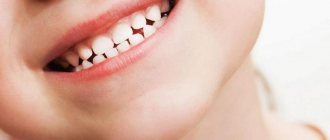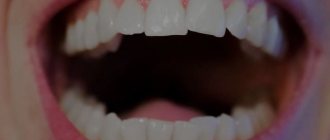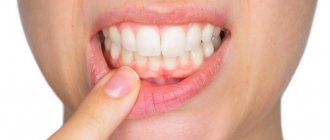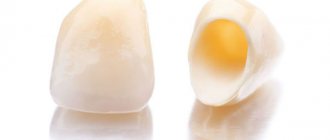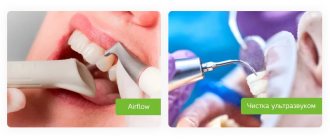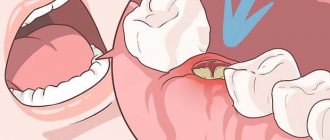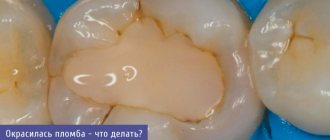Are your teeth too close together? Does this result in the formation of a dental arch shortened by several millimeters? Does this affect facial symmetry? Most likely, we are talking about crowded teeth. The problem lends itself to an effective orthodontic solution. If treatment is approached comprehensively, then in a few months the defect can be removed and you can boast of your beautiful and healthy teeth. What exactly should you pay attention to when treating dental crowding? Experts spoke about this.
What is crowded teeth in children and adults, and why does it occur?
Crowding of teeth is a common problem in which the dental units are located too close to each other, some crowns “overlap” the bottoms of the neighboring ones, forming an unaesthetic picture.
Teeth can be crowded in the middle, on the sides, and also in both the back and frontal areas at the same time. Most often, dentists diagnose crowding of the front teeth of the lower jaw.
There are three stages of dental crowding:
- Third or advanced, when the dental arch decreases in size by approximately 7 millimeters;
- The middle stage of dental crowding, when the row of teeth is shortened by 4 - 6 millimeters;
- Initial or first, when the size of the dental arch is reduced by 2 - 3 millimeters.
Forecast. Prevention
When treating crowded teeth syndrome, the prognosis is favorable in most cases. Thanks to the use of modern therapeutic methods, it is possible to restore the aesthetic appearance and functionality of the maxillofacial apparatus. The prognosis for restoration of the gums and maxillofacial area directly depends on the degree of development of crowding and the timeliness of contacting a specialist.
Depending on the degree of development of the patient’s pathology, the duration of full treatment ranges from 1.5 to 3 years.
If left untreated, plaque and tartar appear, and gingivitis, caries, and various periodontal diseases may develop. This leads to premature tooth loss.
The best method of prevention is a systematic visit to the dentist. The doctor at the appointment will help to timely identify negative factors, predisposition to anomalies and take measures to reduce negative consequences.
Why do some people experience crowded teeth while others do not have the problem?
There are many reasons for crowded teeth. Let's list the most common ones:
- anatomically large teeth;
- large jaw from birth;
- “extra” teeth;
- wisdom teeth that were recommended to be removed, but were not removed after eruption;
- “bad habits” in young patients (thumb sucking, pacifiers, artificial feeding);
- breathing through the mouth, caused by ENT diseases, scoliosis, and other factors. Against the background of oral breathing, the child’s dental system is formed incorrectly;
- lack of minerals and vitamins necessary for the formation of healthy teeth;
- early removal or loss of baby teeth (for example, due to mechanical trauma).
Causes of pathology
The reasons may be different:
- Irregularly shaped teeth.
- Improper jaw development.
- Underdevelopment of dental arches; excessive development of teeth or, conversely, very small teeth.
- Poor heredity in terms of jaw formation and tooth growth.
Crowding of a number of teeth in a child - how to spot it in time and how to help?
Children's crowding of teeth, as a rule, occurs and is noticeable even at the stage of eruption of baby teeth. In the period from 4 to 6 years, when increased growth of the jaws occurs, a space (the so-called trema) is formed between the baby teeth, which is necessary for the eruption of permanent teeth. If the space does not form, it means that the eruption of the molars will be late, or there are other problems with the jaw.
It is important! During the period of eruption of molars, it is important to check the ENT organs and correct existing problems with posture, since these points are interrelated. Against the background of mouth breathing (and correct breathing through the nose), defects of the bite and jaw are formed, including crowding of teeth.
When diagnosing a tendency to crowding of teeth or true crowding of a row, the orthodontist recommends step-by-step treatment:
- wearing myofunctional trainers that will correct the position of the jaws and help align the dentition at the teething stage;
- myofunctional gymnastics exercises, which will help “pump up” the chewing and facial muscles, normalize muscle tone in this area;
- the use of corrective elements for teeth and jaws: plates, dental activators, palatal expanders, etc.
If crowded teeth are diagnosed in a teenager between the ages of 13 and 16, dentists may recommend the use of braces or aligners. In advanced cases, ligature braces are recommended.
Treatment methods for crooked teeth
Modern orthodontic designs can successfully treat crowding. Based on the characteristics of the clinical picture of the pathology, one or another correction procedure may be indicated.
Braces
Most often, such treatment is justified if the pathology is not too serious. The course of correcting the defect will take several months; if you follow all the specialist’s recommendations, the effect of treatment is noticeable and lasting. For each patient, the time for using the systems is selected individually - it depends on the age group, the quality of the periodontal tissues and the presence of concomitant diagnoses. Various models of such structures allow you to align the jaw row due to the formation of an oval of the correct shape formed by an arch. Thus, abnormally overgrown organs end up in the right place.
Removal of a tooth
If there is insufficient free space in the row of the lower jaw, especially in the stage of a developed type of crowding, the patient has no choice but to resort to the removal of part of the organs. First, the outermost lateral teeth, also called wisdom teeth, are amputated. If the clinical situation is too advanced, sometimes even such a radical measure is not enough and the premolars must be removed. This mainly affects the lower jaw, since it is much more susceptible to deformation and mechanical stress than the upper jaw. Due to this, its natural size becomes a little smaller over time, and with such a diagnosis this is quite an aggravating factor. Depending on the severity of the disease, the course of treatment can range from 2-3 weeks to 1.5-2 months. After removal of all necessary organs, the installation of orthodontic structures is indicated. The cost of the removal procedure is standard and depends on the region, clinic and the cost of pain medication.
Extension
Such treatment will be effective only if the pathology is not very pronounced. It is carried out by lightly smoothing the enamel surface (mechanical separation principle) or installing spacers (physiological separation option). The first case is the opportunity to free up to 0.5 cm of the interdental space. It should be noted that many experts consider separation to be a fairly worthy alternative to amputation of jaw fragments. The procedure is carried out quickly, sometimes 2-3 visits to the dentist are enough.
Leveling devices are used for initial and moderate severity of anomalies.
- Aligners.
With the help of aligners, treatment proceeds much slower (within 1 year), but this procedure is much more comfortable for the person. The cost of structures is several times more expensive than braces, but the effectiveness of such treatment is much higher.
The principle of crowding relief is to apply light but constant pressure to the row of jaws. With the help of the habituation reflex, organ fragments are transferred to the correct position. There is a psychological “memorization” of the teeth in the desired position, which develops during the treatment process and is gradually corrected with each subsequent removable aligner. They are transparent and thin in appearance and are not difficult to wear. The course of treatment is about a year. Their cost is determined by the complexity of the correction and the number of aligners performed.
- Expansion of the dentition using plates.
Such manipulations are allowed only after a thorough study of the qualitative condition of periodontal tissues. The doctor records the presence of the amount of hard bone required for the procedure. The manipulation itself is carried out in several ways, but plates are often used. The effect is achieved due to the systematic pressure of the expansion plate on a number of jaws and gradually giving its fragments the correct position. Products are made individually. The best results in this case are observed in children and adolescents, whose bones are not yet fully formed and are more susceptible to changes in position than adults. Standard design: metal plate, mounting screws and spring. The devices are secured with clips. The course of treatment depends on the situation. Typically this is a period of 6 to 12 months.
Can crowded teeth develop after wisdom teeth erupt?
Yes maybe. This is a fairly common picture when a person had relatively straight teeth up to a certain stage, but after the third molars came out, pronounced crowding began to be observed.
Crowding occurs as a result of the pressure of the wisdom tooth on the remaining teeth, the row moves, healthy teeth “find” each other, which is why they deteriorate.
The situation is aggravated if wisdom teeth come out on both the left and the right at the same time.
Crowding of the dentition can be observed even if there is room in the jaw for a wisdom tooth, and, moreover, it is inevitable if the “eights” are located abnormally.
To solve the problem of crowded units, wisdom teeth are recommended for removal. It is also better to remove the “eights” if the x-ray shows their incorrect position. These measures are recommended as prevention.
A little theory:
Dentists, and especially we, orthodontists, very often use the term “Occlusion”, which is incomprehensible to many. Don't be alarmed, everything is very simple. I'll explain now.
Occlusion
- nothing more than the contact of the teeth of the upper and lower jaws.
In the modern world of dentistry, the understanding of occlusion is complex and includes the relationship of teeth, masticatory muscles and temporomandibular joints. And we always look at the bite precisely from the point of view of the function of the bite or its violation - bite dysfunction.
We consider occlusion as any contact between the incisal edges or chewing surfaces of the maxillary and mandibular teeth.
Why are these contacts between teeth so important?
Besides the fact that crooked teeth themselves look ugly and unaesthetic, but seriously, occlusion is very important in order to provide you with competent and optimal treatment. If you look carefully in the mirror at your teeth, at their contact with each other, you will see that the teeth have tubercles at the end, which are called fissure-tubercle contacts. And correct, stable occlusion is ensured by multiple uniform fissure-tubercle contacts of the lateral teeth, which are characterized by the presence of antagonistic cusp slopes on the occlusal surface of the contacts.
Cool and difficult with tuberculate contacts?
We’re done with the theory)) I’ll just note that correct occlusal contacts provide axial load on the teeth (we will see this in the photo of our patient), create stable central occlusion and eliminate overload of the tissues around the tooth - the periodontium.
For us orthodontists, occlusion is the central point of treatment, which should generally be aimed at optimizing the occlusal relationship of the patient's teeth with each other.
Molars are the 6th, 7th and 8th molars. Molars are also called molars, respectively. In the photo above it’s the molars. They perform the most important function in the human body - chewing and grinding food, which is why dentists often call them “chewing”. But the most harmful of the molars are the eights, or “wisdom teeth,” which can greatly harm the patient when they erupt.
So in this case, the “wisdom teeth” of the lower jaw had a fairly strong negative impact on the patient’s lower jaw, practically pushing the canine out of its place in the dentition. So, let's see.
Can teeth crowding be treated with aligners?
Yes, such treatment is in demand. Aligners are aligners, a removable orthodontic device made of polycarbonate. A more aesthetic, but at the same time expensive alternative to braces. Aligners exert constant pressure on crowded teeth, provoking the natural resorption of alveolar bone tissue in the direction of tooth movement, while bone tissue is formed in the opposite direction. Thus, the crowded teeth move along a trajectory pre-planned by the orthodontist, and the crowding gradually goes away. Dental aligners are distinguished by their aesthetic appearance, compact size, easy to remove and put on, invisible on the teeth, and easy to care for throughout the entire treatment period.
Correction of dental defects
Correction with braces. The main problem when installing braces for an adult is that his jaw is already fully formed. Sometimes, when getting braces, several teeth need to be removed.
Modern dentistry offers several options for fixed structures:
- Metal braces that quickly correct dental defects.
- Plastic braces are less noticeable, but they can be stained by food and break fairly quickly.
- Ceramic and sapphire braces have a beautiful appearance and withstand physical activity quite well, but the braces are very expensive.
Many patients are concerned about the aesthetic impression they will make on others when they appear with braces on their teeth. Such patients are offered structures that are installed on the teeth from the tongue side, so they become invisible to prying eyes.
Correcting crowded teeth with braces takes quite a long time (about a year), but here the patient has to sacrifice aesthetics and choose health benefits.
Can crowded teeth be treated without braces?
Yes, treatment without braces is acceptable. If the patient does not want to get braces, or there are objective medical reasons for this, it is recommended to treat the defect using tooth separation. The lateral interdental areas are lightly ground at each edge. As a result, it is possible to obtain the previously missing three millimeters to straighten the dentition. Also, if teeth are slightly crowded, specialists may suggest installing veneers or lumineers. Dentists specialize in treating crowded teeth with braces, aligners, and other effective techniques. An integrated approach to solving the problem, maximum preservation of the health of your teeth, ideal results in a short period of treatment. Schedule a consultation today to enjoy a healthy, beautiful smile in no time.
Recommendations for using braces
Although braces can correct even severe crowding, it will take time and repeated visits to a specialist. In addition, the patient needs to change eating habits and pay more attention to oral hygiene.
- Brush your teeth under the orthodontic product. Orthodontists have developed a number of recommendations, compliance with which will make using the device more comfortable:
- Brushing your teeth after every meal is mandatory. The optimal solution would be to purchase a professional toothbrush, in addition to using dental floss and an interdental brush.
- Avoiding seeds and nuts while wearing braces. Particulate matter can damage the structure, resulting in the need for replacement. Care should be taken when handling any solid food: raw vegetables, fruits, meat fibers. It is not recommended to chew them - it is better to cut them into small pieces and chew them thoroughly.
- Excluding viscous products from the menu (caramel, nougat, chewing gum). They clog the grooves in the shoulder straps and are almost impossible to clean.
- Reasonable consumption of hot and cold drinks. A sharp change in temperature leads to thermal expansion of the metal elements, as a result of which the braces can peel off from the enamel.
- Regular visits to a specialist and immediate contact with him in the event of damage to the structure.
Additionally, caution should be exercised when consuming coloring foods and beverages while treating crowding. Coffee, strong tea, and soda can stain the transparent elements of the braces system and make it more noticeable.
After fixing the device, the patient may experience discomfort and pain in the jaw area during the first two weeks. Such manifestations are natural and should not cause concern. Over time, the discomfort disappears, and the bandage becomes familiar.
Modern designs are made from the most delicate materials, but soft tissue injuries may occur during installation. In order not to damage the gums, it is necessary to use plastic wax, provided in time by a specialist. If the mucous membrane is still red and swollen, it is recommended to use anti-inflammatory drugs until the wound is completely healed.
Diagnostics
Diagnosis of crowded teeth includes the following steps:
- visual inspection;
- X-ray diagnostics or orthopantomogram.
Additional diagnostic methods may be used:
- Pon's method - determining the width of the dentition.
- Corkhouse method - measuring the distance between the width of the incisors and the length of the frontal section.
- Snagina's method involves measuring the width of the crown, dental arch, and a line passing along the level of the apexes of the roots of the teeth (apical base).
Advantages and disadvantages of aesthetic correction
In terms of price, aesthetic dental restoration in Moscow may not be the cheapest pleasure. But on the other hand, veneers are quickly made and installed quite simply, while braces need to be worn for a long time, and after treatment is completed, you continue to use a removable orthodontic structure and retainers so that the teeth do not return to their previous position. In addition, those around you who are unaware of the intricacies of treatment will never notice that the teeth have been corrected with veneers. But the installed braces system cannot always be hidden from prying eyes.
However, this method also has disadvantages.
- The more the teeth are rotated around the axis, the more tissue will have to be ground off to install ceramic plates. Sometimes it is necessary to perform large-scale preparation, which increases the risk of damage to the pulp.
- When using veneers, it is quite difficult to perfectly match them to the natural tone of the ground tooth. Tooth enamel and the different layers of underlying dentin have different shades and varying degrees of transparency. They will noticeably affect the aesthetics of the tooth restored with a translucent plate, and a professional will easily notice the “substitution”.
Is it possible to fix teeth without braces?
Yes, but remember that veneers have a limited lifespan and will likely need to be replaced in the future.
Comparison of aligners and braces
| Braces | Mouthguards | |
| Predicting the result of the adjustment | Approximate planning taking into account dental mechanics | The patient sees the exact result at the 3D planning stage |
| Aesthetics | Noticeable when talking, smiling (except for lingual models) | Invisible to others even close up (face-to-face) |
| Removable\non-removable | Only an orthodontist can install and remove braces. | The patient removes and installs the corrector himself |
| Comfort | The design of locks, clamps, additional elements can injure the mucous membrane, impair sound pronunciation during the adaptation period, there are dietary restrictions | Invisible, flexible, lightweight biopolymer devices, do not affect diction, do not require a change in diet, and are easy to maintain |
| Enamel injury | Under the locks, demineralization is common, the accumulation of bacterial plaque under the tension arc, between the locks contributes to caries | Does not injure the enamel layer or soft tissues; plaque from the surface is easily removed with a regular toothbrush |
| How often should you visit the orthodontist? | To activate ligature devices, a doctor is visited every 3-4 weeks, self-ligating devices - every 2-2.5 months. | every 2-3 months |
Stages
The pathology has three stages of progression:
- simple - the error within a single part of the jaw is no more than 3 mm;
- medium – the size of the deviation is much larger and reaches 6 mm;
- strong - over 7 mm, which is considered an advanced state of the structure of the jaw row.
The phenomenon can be characteristic of one jaw or its fragment, or of the entire dentition.
What is a mesial bite, what methods are used to correct the defect in adults and children?
Come here and read reviews about Clarity ceramic braces, as well as a lot of useful information about the systems.
At this address https://orto-info.ru/zubocheliustnye-anomalii/okklyuzii/otkryityj-prikus.html we will talk about the treatment of open bite in children.
Degrees and symptoms of the disease
Orthodontists distinguish several degrees of crowding, each of which has its own characteristics of symptoms.
- The first (mild) degree is characterized by minor changes in the position of 1-2 dental units in a row.
- The average degree manifests itself as a significant displacement of 1-2 teeth. This can be a shift relative to the normal position, tilt or rotation around its axis. The amount of displacement does not exceed 5-6 mm.
- The third (severe) degree is characterized by significant deformation of the dentition, which is clearly visible to others when smiling and talking.
The greater the deformity, the more difficult oral care becomes. Changing the position of teeth contributes to the formation of hard-to-reach areas in which large amounts of plaque accumulate. This significantly increases the risk of caries, gingivitis, periodontitis and other dental diseases.

